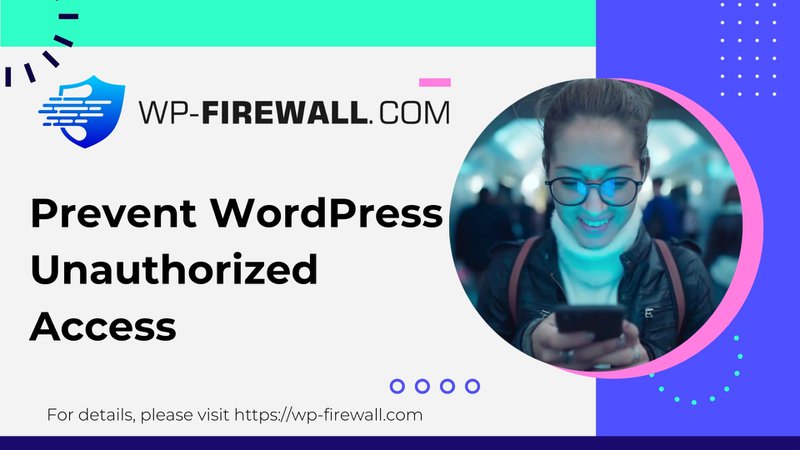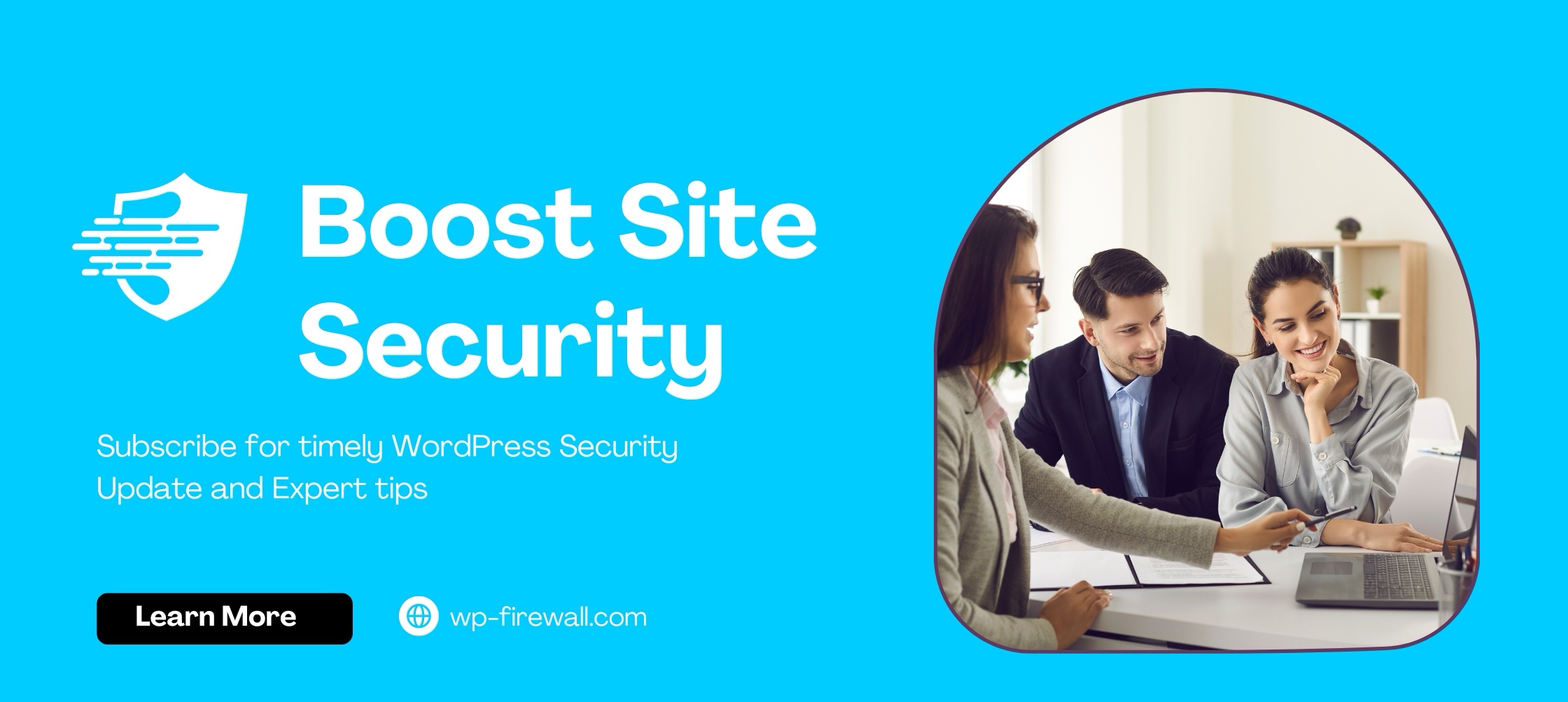
ওয়ার্ডপ্রেস প্রিভিলেজ বৃদ্ধি এবং অননুমোদিত অ্যাক্সেস কীভাবে প্রতিরোধ করা যায় তা বোঝা
আপনার ওয়ার্ডপ্রেস সাইট আপস করা হয়েছে যে খুঁজে একটি সকালে ঘুম থেকে কল্পনা করুন. প্রশাসনিক সুবিধা সহ অপরিচিত ব্যবহারকারীর অ্যাকাউন্টগুলি উপস্থিত হয়েছে, সেটিংস পরিবর্তন করা হয়েছে এবং স্প্যাম সামগ্রী আপনার পৃষ্ঠাগুলিকে প্লাবিত করছে৷ এই দুঃস্বপ্নের দৃশ্যটি অনেক ওয়ার্ডপ্রেস সাইটের মালিকদের জন্য একটি বাস্তবতা এবং এটি প্রায়ই বিশেষাধিকার বৃদ্ধি হিসাবে পরিচিত নিরাপত্তা লঙ্ঘনের ফলাফল।
এই ব্লগ পোস্টে, আমরা বিশেষাধিকার বৃদ্ধির ধারণা, এটি কীভাবে ওয়ার্ডপ্রেসে প্রকাশ করে এবং আপনার সাইটকে রক্ষা করার জন্য কার্যকরী কৌশল প্রদান করব। একটি শীর্ষস্থানীয় ওয়ার্ডপ্রেস ফায়ারওয়াল প্লাগইন বিক্রেতা এবং নিরাপত্তা পরিষেবা প্রদানকারী হিসাবে, WP-Firewall আপনাকে এই ধরনের হুমকির বিরুদ্ধে আপনার সাইটকে সুরক্ষিত করতে সাহায্য করতে প্রতিশ্রুতিবদ্ধ।
ওয়ার্ডপ্রেসে প্রিভিলেজ এসকেলেশন কি?
ওয়ার্ডপ্রেসের পরিপ্রেক্ষিতে, "সুবিধা" বলতে ব্যবহারকারীর অ্যাকাউন্টগুলিতে নির্ধারিত অনুমতি বা ক্ষমতা বোঝায়। এই অনুমতিগুলি প্রশাসক, সম্পাদক বা গ্রাহকের মতো তাদের ভূমিকার উপর ভিত্তি করে ব্যবহারকারীরা আপনার সাইটে কী করতে পারে এবং কী করতে পারে না তা নির্দেশ করে৷ বিশেষাধিকার বৃদ্ধি ঘটে যখন একজন ব্যবহারকারী তাদের থাকা উচিত তার চেয়ে বেশি অনুমতি লাভ করে, যা তাদের মনোনীত ভূমিকার বাইরে ক্রিয়া সম্পাদন করতে দেয়।
উদাহরণস্বরূপ, একজন সম্পাদক হঠাৎ করে একজন প্রশাসকের মতো প্লাগইন এবং সেটিংস পরিচালনা করতে সক্ষম হওয়া বিশেষাধিকার বৃদ্ধির একটি ক্লাসিক কেস। কোডিং ত্রুটি, প্লাগইন বা থিমের দুর্বলতা বা ভুল কনফিগারেশনের কারণে এটি ঘটতে পারে। হ্যাকাররা অননুমোদিত অ্যাক্সেস পেতে, সাইটের ডেটা ম্যানিপুলেট করতে, ম্যালওয়্যার ইনস্টল করতে বা এমনকি আপনার নিজের ওয়েবসাইট থেকে আপনাকে লক করতে এই দুর্বলতাগুলিকে কাজে লাগায়৷
কিভাবে বিশেষাধিকার বৃদ্ধি ঘটবে?
বিভিন্ন দুর্বলতা এবং ভুল কনফিগারেশনের মাধ্যমে বিশেষাধিকার বৃদ্ধি ঘটতে পারে। এটি ঘটতে পারে এমন কিছু সাধারণ উপায় এখানে রয়েছে:
1. প্লাগইন এবং থিমের দুর্বলতা
পুরানো বা খারাপভাবে কোডেড প্লাগইন এবং থিম হ্যাকারদের জন্য একটি গেটওয়ে হতে পারে। আপনি যদি আপনার প্লাগইন এবং থিম আপ টু ডেট না রাখেন তবে পরিচিত দুর্বলতা সহ পুরানো সংস্করণগুলিকে কাজে লাগানো যেতে পারে৷ উদাহরণস্বরূপ, ব্যবহারকারী নিবন্ধন প্লাগইনের একটি সাম্প্রতিক দুর্বলতা 70,000 টিরও বেশি সাইটকে ঝুঁকিতে ফেলেছে।
2. Nulled প্লাগইন এবং থিম ব্যবহার করা
শূন্য প্লাগইন এবং থিমগুলি প্রায়ই তাদের মধ্যে এমবেড করা দূষিত কোড সহ আসে। আক্রমণকারীরা এই কোডটি ব্যাকডোর ইমপ্লান্ট করতে ব্যবহার করতে পারে, তাদের আপনার সাইটে গোপন অ্যাক্সেস দিতে পারে। এটি ডেটা লঙ্ঘন, ডেটা ক্ষতি বা এমনকি একটি সম্পূর্ণ সাইট টেকওভার হতে পারে।
3. ব্রেকিং অথেনটিকেশন মেকানিজম
হ্যাকাররা ব্যবহারকারীর গণনা বা ফিশিং আক্রমণের মাধ্যমে প্রমাণীকরণ প্রক্রিয়া ভেঙে দিতে পারে। ব্যবহারকারীর গণনা একটি সাইটে বৈধ ব্যবহারকারীর নাম সনাক্ত করা জড়িত, যা তারপর নৃশংস শক্তি আক্রমণের জন্য লক্ষ্য করা যেতে পারে। ফিশিং আক্রমণ ব্যবহারকারীদের প্রতারণামূলক ইমেল বা সাইটের মাধ্যমে তাদের লগইন শংসাপত্র প্রদানের জন্য প্রতারণা করে।
4. SQL ইনজেকশন (SQLi) এবং ক্রস-সাইট স্ক্রিপ্টিং (XSS) আক্রমণ
দুর্বল ইনপুট বৈধতা হ্যাকারদের ডাটাবেস ম্যানিপুলেট বা ব্যবহারকারীর সেশন হাইজ্যাক করার জন্য দূষিত SQL বা স্ক্রিপ্ট ইনজেক্ট করার অনুমতি দিতে পারে। ডাটাবেসে সরলীকৃত বা অনিরাপদ অ্যাক্সেস আক্রমণকারীদের জন্য সুবিধাপ্রাপ্ত ক্রিয়াকলাপ চালানো সহজ করে তুলতে পারে।
5. ভুল কনফিগার করা ব্যবহারকারীর ভূমিকা এবং অনুমতি
ভুলভাবে ব্যবহারকারীর ভূমিকা নির্ধারণ করা বা খুব বিস্তৃত অনুমতি প্রদান অপব্যবহারের সুযোগ খুলে দিতে পারে। উদাহরণস্বরূপ, শুধুমাত্র একজন গ্রাহক হওয়া উচিত এমন কাউকে সম্পাদকের ভূমিকা অর্পণ করা বিশেষাধিকার বৃদ্ধির দিকে নিয়ে যেতে পারে।
6. ওয়ার্ডপ্রেস ফাইল সরাসরি অ্যাক্সেস
ফাইল ইন্ডেক্সিংয়ের মাধ্যমে ওয়ার্ডপ্রেস ফাইলগুলিতে সরাসরি অ্যাক্সেস সংবেদনশীল ফাইলগুলিকে প্রকাশ করতে পারে, যা বিশেষাধিকার বৃদ্ধির দিকে পরিচালিত করে। অননুমোদিত অ্যাক্সেস থেকে রক্ষা করার জন্য ফাইল ইন্ডেক্সিং নিষ্ক্রিয় করা অত্যন্ত গুরুত্বপূর্ণ।
কিভাবে বিশেষাধিকার বৃদ্ধি আক্রমণ সনাক্ত করতে?
বিশেষাধিকার বৃদ্ধির আক্রমণ সনাক্ত করা চ্যালেঞ্জিং হতে পারে কিন্তু আপনার সাইটের নিরাপত্তা বজায় রাখার জন্য অপরিহার্য। এখানে কিছু লাল পতাকা রয়েছে যা দেখার জন্য:
1. সেটিংসে অপ্রত্যাশিত পরিবর্তন
আপনি যদি আপনার সাইটের সেটিংসে পরিবর্তনগুলি লক্ষ্য করেন যা আপনি করেননি, এটি একটি প্রধান সতর্কতা চিহ্ন৷ ব্যবহারকারী এবং এন্ট্রিগুলির জন্য আপনার সাইটের কার্যকলাপের লগগুলি পরীক্ষা করুন যা আপনি চিনতে পারেন না৷
2. নতুন এবং অজানা ব্যবহারকারী অ্যাকাউন্ট
নিয়মিত আপনার ব্যবহারকারী তালিকা পরীক্ষা করুন. অ্যাডমিন বা এডিটরের মতো উন্নত ভূমিকা সহ নতুন ব্যবহারকারীরা আপনার অনুমোদন ছাড়াই উপস্থিত হলে, এটি একটি বিশেষাধিকার বৃদ্ধি আক্রমণ নির্দেশ করতে পারে।
3. অননুমোদিত বিষয়বস্তু পরিবর্তন
পোস্ট, পৃষ্ঠা বা মিডিয়া ফাইলে অননুমোদিত পরিবর্তনগুলি বিশেষাধিকার বৃদ্ধির একটি শক্তিশালী সূচক হতে পারে। বিষয়বস্তু পরিবর্তনের জন্য নজর রাখুন যা আপনি অনুমোদন করেননি৷
4. কার্যকলাপ লগ সন্দেহজনক কার্যকলাপ
অস্বাভাবিক কার্যকলাপের জন্য আপনার কার্যকলাপ লগগুলি পর্যালোচনা করুন, যেমন একাধিক ব্যর্থ লগইন প্রচেষ্টা, অপ্রত্যাশিত ভূমিকা পরিবর্তন, বা অপরিচিত IP ঠিকানাগুলি। এই লগগুলিতে রেকর্ড করা সন্দেহজনক ক্রিয়াগুলি চলমান বা বিশেষাধিকার বৃদ্ধির আক্রমণের সূচকগুলি প্রকাশ করতে পারে৷
কিভাবে বিশেষাধিকার বৃদ্ধি আক্রমণ ঠিক করবেন?
আপনি যদি সন্দেহ করেন যে আপনার WordPress সাইটটি একটি বিশেষাধিকার বৃদ্ধি আক্রমণের শিকার হয়েছে, তাহলে দ্রুত কাজ করা অত্যন্ত গুরুত্বপূর্ণ৷ কার্যকরভাবে সাড়া দেওয়ার জন্য এখানে একটি ধাপে ধাপে নির্দেশিকা:
1. সাময়িকভাবে আপনার ওয়েবসাইট নামিয়ে নিন
আরও অননুমোদিত অ্যাক্সেস এবং ক্ষতি রোধ করতে সাময়িকভাবে আপনার ওয়েবসাইটটি সরিয়ে দিন। দর্শকদের একটি রক্ষণাবেক্ষণ পৃষ্ঠায় পুনঃনির্দেশিত করুন যাতে আপনি সমস্যাটি সমাধান করার সময় তাদের অবগত রাখতে পারেন।
2. WP-Firewall ব্যবহার করে ওয়েবসাইট স্ক্যান করুন
WP-Firewall'এর শক্তিশালী নিরাপত্তা সরঞ্জাম ব্যবহার করে আপনার ওয়েবসাইটের একটি পুঙ্খানুপুঙ্খ স্ক্যান করুন। এটি আপনাকে কোনও ক্ষতিকারক কোড, ম্যালওয়্যার বা সন্দেহজনক কার্যকলাপ সনাক্ত করতে সাহায্য করবে৷
3. সমস্ত পাসওয়ার্ড রিসেট করুন
অবিলম্বে সমস্ত অ্যাডমিন এবং ব্যবহারকারীর পাসওয়ার্ড রিসেট করুন এবং এই পরিবর্তন সম্পর্কে সবাইকে জানান৷ নিশ্চিত করুন যে সমস্ত ব্যবহারকারীর অ্যাকাউন্ট, বিশেষ করে যাদের উচ্চতর সুবিধা রয়েছে, তাদের শক্তিশালী এবং অনন্য পাসওয়ার্ড রয়েছে৷ আক্রমণকারীদের আপোসকৃত শংসাপত্রগুলি পুনরায় ব্যবহার করা থেকে আটকাতে এই পদক্ষেপটি অত্যন্ত গুরুত্বপূর্ণ৷
4. ব্যবহারকারীর অ্যাকাউন্ট অডিট করুন
আপনার সাইটে ব্যবহারকারীর অ্যাকাউন্টগুলির একটি সম্পূর্ণ অডিট পরিচালনা করুন৷ সন্দেহজনক মনে হচ্ছে বা আপনার অজান্তেই তৈরি করা হয়েছে এমন যেকোনো অ্যাকাউন্ট সরিয়ে দিন। নিশ্চিত করুন যে বৈধ ব্যবহারকারীদের জন্য ভূমিকা এবং অনুমতি উপযুক্ত।
5. সন্দেহজনক প্লাগইন বা থিমগুলি সরান৷
আক্রমণের জন্য এন্ট্রি পয়েন্ট হতে পারে এমন সন্দেহজনক প্লাগইন বা থিম আনইনস্টল করুন। সেগুলি আপনার অজান্তেই ইনস্টল করা হয়েছে বা তাদের নাম সন্দেহজনক কিনা তা দ্বারা তাদের সনাক্ত করুন৷ কখনও কখনও, নিরাপত্তার স্বার্থে সাময়িকভাবে কার্যকারিতা ত্যাগ করা প্রয়োজন। নিশ্চিত করুন যে এই উপাদানগুলি পুনরায় ইনস্টল করার কথা বিবেচনা করার আগে দুর্বলতার জন্য পুঙ্খানুপুঙ্খভাবে পরীক্ষা করা হয়েছে।
6. সাইট সল্ট এবং নিরাপত্তা কী রিসেট করুন
বিদ্যমান সেশন এবং কুকি বাতিল করে নিরাপত্তার একটি অতিরিক্ত স্তর যোগ করতে আপনার সাইটের সল্ট এবং নিরাপত্তা কী রিসেট করুন। WP-Firewall তার পোস্ট-হ্যাক ক্লিনআপ পরিষেবার অংশ হিসাবে এই বৈশিষ্ট্যটি অফার করে, এটি আপনার সাইটের প্রমাণীকরণ ডেটা সুরক্ষিত করা সহজ করে তোলে।
7. কোর, প্লাগইন এবং থিম আপডেট করুন
আপনার ওয়ার্ডপ্রেস কোর, প্লাগইন এবং থিম আপ টু ডেট আছে তা নিশ্চিত করুন। পুরানো সংস্করণে দুর্বলতা আক্রমণের জন্য একটি সাধারণ প্রবেশ বিন্দু হতে পারে। নিরাপত্তা ফাঁক প্যাচ করতে এবং হুমকির বিরুদ্ধে আপনার সাইটকে রক্ষা করার জন্য নিয়মিত আপডেট অপরিহার্য। WP-Firewall ব্যবহারকারীরা স্টেজিং সাইট এবং স্বয়ংক্রিয় ব্যাকআপের মতো বৈশিষ্ট্যগুলি থেকে উপকৃত হতে পারে যা আপডেট প্রক্রিয়াটিকে নিরাপদ এবং মসৃণ করে তোলে।
8. 2FA বা ক্যাপচা প্রয়োগ করুন
আপনি যদি ইতিমধ্যে এটি না করে থাকেন তবে আপনার লগইন প্রক্রিয়াতে দ্বি-ফ্যাক্টর প্রমাণীকরণ (2FA) বা ক্যাপচা যোগ করুন। এই নিরাপত্তা ব্যবস্থাগুলি আক্রমণকারীদের কাটিয়ে ওঠার জন্য আরেকটি বাধা যোগ করে অননুমোদিত প্রবেশের ঝুঁকি উল্লেখযোগ্যভাবে হ্রাস করে৷
9. সাইট মনিটর
আক্রমণের পরে কিছু সময়ের জন্য আপনার সাইটে ঘনিষ্ঠ নজর রাখুন। নিয়মিত সিকিউরিটি স্ক্যান এবং অ্যাক্টিভিটি মনিটরিং আপনাকে যেকোন নতুন সন্দেহজনক অ্যাক্টিভিটি তাড়াতাড়ি শনাক্ত করতে সাহায্য করবে, প্রয়োজনে আপনাকে দ্রুত প্রতিক্রিয়া জানাতে সাহায্য করবে।
বিশেষাধিকার বৃদ্ধি আক্রমণের পরিণতি কি?
বিশেষাধিকার বৃদ্ধির আক্রমণ আপনার ওয়ার্ডপ্রেস সাইটে বিধ্বংসী প্রভাব ফেলতে পারে। যখন কেউ অননুমোদিত উচ্চতর সুযোগ-সুবিধা লাভ করে, তখন এর প্রতিক্রিয়া মারাত্মক হতে পারে। এখানে আপনাকে যা সচেতন হতে হবে:
1. অননুমোদিত অ্যাডমিন অ্যাক্সেস
হ্যাকারদের লক্ষ্য প্রথম জিনিসগুলির মধ্যে একটি হল অননুমোদিত অ্যাডমিন অ্যাক্সেস। প্রশাসক বিশেষাধিকারের সাথে, তারা সাইট সেটিংস পরিবর্তন করতে পারে, যার ফলে ভুল কনফিগারেশন বা এমনকি সাইট ডাউনটাইম হতে পারে। আপনার সাইটটিকে সম্পূর্ণ অফলাইনে খুঁজে পেতে ঘুম থেকে উঠে কল্পনা করুন বা অদ্ভুতভাবে আচরণ করছেন কারণ একজন হ্যাকার ব্যবহারকারীর অনুমতি বা ডিরেক্টরি অবস্থানের মতো গুরুত্বপূর্ণ সেটিংস পরিবর্তন করেছে৷ এই ডাউনটাইম আপনি এবং আপনার ক্লায়েন্ট উভয়ের জন্য একটি দুঃস্বপ্ন হতে পারে।
2. ডেটা চুরি
অ্যাডমিন অ্যাক্সেস সহ হ্যাকাররা সহজেই আপনার সাইট থেকে সংবেদনশীল তথ্য চুরি করতে পারে। এতে ব্যবহারকারীর ডেটা, আর্থিক রেকর্ড এবং আপনার ওয়েবসাইটে সংরক্ষিত অন্যান্য গোপনীয় তথ্য অন্তর্ভুক্ত থাকতে পারে। এই ধরনের তথ্য লঙ্ঘনের গুরুতর আইনি এবং আর্থিক প্রভাব থাকতে পারে।
3. বিষয়বস্তু এবং ফাইল পরিবর্তন
একবার একজন হ্যাকার তাদের বিশেষাধিকার বাড়িয়ে দিলে, তারা আপনার সাইটের বিষয়বস্তু এবং ফাইলগুলি পরিবর্তন করতে, যোগ করতে বা মুছতে পারে। এটি শুধু হতাশাজনক নয়-এটি আপনার সাইটের অখণ্ডতাও নষ্ট করতে পারে। আপনার সাইটে অনুপযুক্ত বা প্রতারণামূলক সামগ্রী খুঁজে পাওয়ার কল্পনা করুন, বা আরও খারাপ, গুরুত্বপূর্ণ ফাইলগুলি অদৃশ্য হয়ে যাচ্ছে।
4. ম্যালওয়্যার ইনস্টলেশন
উচ্চতর সুবিধার সাথে, হ্যাকাররা আপনার সাইটে ম্যালওয়্যার ইনস্টল করতে পারে। এই ম্যালওয়্যার আপনার দর্শকদের সংক্রামিত করতে পারে, তাদের তথ্য চুরি করতে পারে, এমনকি তাদের সিস্টেম হাইজ্যাক করতে পারে। এটি শুধুমাত্র আপনার সাইটের জন্য একটি ঝুঁকি নয় বরং যারা এটি পরিদর্শন করে তাদের প্রত্যেকের জন্যও একটি বিপদ।
5. সাইট ডিফেসমেন্ট
আপত্তিকর বা ক্ষতিকর বিষয়বস্তু প্রদর্শনের জন্য হ্যাকাররা আপনার সাইটের চেহারা পরিবর্তন করতে পারে। সাইট বিকৃতকরণ শুধুমাত্র বিব্রতকর নয় আপনার ব্র্যান্ডের খ্যাতির জন্যও ক্ষতিকর। এটি নিরাপত্তার অভাব প্রকাশ করে এবং দর্শকদের স্থায়ীভাবে দূরে সরিয়ে দিতে পারে।
6. এসইও ইমপ্যাক্ট এবং গুগল ব্ল্যাকলিস্টিং
একটি বিশেষাধিকার বৃদ্ধি আক্রমণ আপনার এসইওকে গুরুতরভাবে প্রভাবিত করতে পারে। যদি আপনার সাইটে আপস করা হয়, গুগলের মতো সার্চ ইঞ্জিন ব্যবহারকারীদের সুরক্ষার জন্য এটিকে কালো তালিকাভুক্ত করতে পারে। এটি জৈব ট্র্যাফিকের উল্লেখযোগ্য হ্রাসের দিকে নিয়ে যায় কারণ আপনার সাইট অনুসন্ধান ফলাফলে প্রায় অদৃশ্য হয়ে যায়। এই ধরনের একটি কালো তালিকা থেকে পুনরুদ্ধার করা সময়সাপেক্ষ এবং ব্যয়বহুল হতে পারে।
7. ব্যবহারকারীর বিশ্বাস, ট্রাফিক এবং রাজস্বের ক্ষতি
এই সমস্ত সমস্যাগুলি ব্যবহারকারীর বিশ্বাসের জন্য একটি বিশাল ধাক্কায় পরিণত হয়। আপস করা হয়েছে এমন সাইটটিতে দর্শকদের ফিরে আসার সম্ভাবনা কম হবে। আপনার ট্রাফিক যেমন হ্রাস পায়, তেমনি আপনার আয়ও কমে যায়। একটি বিশেষাধিকার বৃদ্ধি আক্রমণের প্রত্যক্ষ এবং পরোক্ষ খরচ যথেষ্ট হতে পারে, যা শুধুমাত্র আপনার সাইটের নিরাপত্তা নয় বরং এর লাভকেও প্রভাবিত করে।
কীভাবে আপনার ওয়ার্ডপ্রেস সাইটকে প্রিভিলেজ এসকেলেশন অ্যাটাক থেকে রক্ষা করবেন?
বিশেষাধিকার বৃদ্ধির আক্রমণ প্রতিরোধ করা আপনার ওয়ার্ডপ্রেস সাইটের নিরাপত্তা এবং অখণ্ডতা বজায় রাখার জন্য গুরুত্বপূর্ণ। কয়েকটি সক্রিয় পদক্ষেপ বাস্তবায়ন করে, আপনি এই ধরনের আক্রমণের ঝুঁকি উল্লেখযোগ্যভাবে কমাতে পারেন।
1. WP-Firewall ব্যবহার করুন
আপনার সাইটের নিরাপত্তা জোরদার করার সবচেয়ে সহজ উপায় হল WP-Firewall এর মত একটি নির্ভরযোগ্য নিরাপত্তা প্লাগইন ব্যবহার করা। WP-Firewall ব্যাপক ওয়েবসাইট নিরাপত্তা বৈশিষ্ট্য যেমন ম্যালওয়্যার স্ক্যানিং এবং পরিষ্কার, ফায়ারওয়াল সুরক্ষা এবং বট সুরক্ষা প্রদান করে। WP-Firewall আপনাকে দুর্বলতাগুলিকে শোষিত করার আগে সনাক্ত করতে এবং মোকাবেলায় সহায়তা করতে পারে।
2. নিয়মিত আপনার ওয়ার্ডপ্রেস কোর, প্লাগইন এবং থিম আপডেট করুন
আপনার ওয়ার্ডপ্রেস কোর, প্লাগইন এবং থিম আপডেট রাখা অপরিহার্য। আপডেটে প্রায়ই নিরাপত্তা প্যাচ অন্তর্ভুক্ত থাকে যা পরিচিত দুর্বলতার সমাধান করে। বর্তমান থাকার মাধ্যমে, আপনি আক্রমণকারীদের সুযোগ-সুবিধা বাড়াতে পুরানো সফ্টওয়্যারকে কাজে লাগানোর সম্ভাবনা কমিয়ে দেন।
3. শুধুমাত্র সম্মানজনক উত্স থেকে প্লাগইন এবং থিম পান৷
সর্বদা সম্মানিত উত্স থেকে প্লাগইন এবং থিম ডাউনলোড করুন। বাতিল সংস্করণগুলি এড়িয়ে চলুন, কারণ এতে প্রায়ই লুকানো দূষিত কোড থাকে। আপনি নিরাপদ এবং নির্ভরযোগ্য সফ্টওয়্যার ব্যবহার করছেন তা নিশ্চিত করতে ওয়ার্ডপ্রেস প্লাগইন ডিরেক্টরি বা বিশ্বস্ত মার্কেটপ্লেসের মতো অফিসিয়াল রিপোজিটরিগুলিতে লেগে থাকুন৷
4. শক্তিশালী পাসওয়ার্ড নীতি এবং 2FA নিয়োগ করুন
শক্তিশালী পাসওয়ার্ড নীতি প্রয়োগ করা ব্যবহারকারীর অ্যাকাউন্ট সুরক্ষিত করার জন্য একটি গুরুত্বপূর্ণ পদক্ষেপ। নিশ্চিত করুন যে আপনার ব্যবহারকারীরা জটিল পাসওয়ার্ড ব্যবহার করেন যা অক্ষর, সংখ্যা এবং বিশেষ অক্ষরকে একত্রিত করে। অতিরিক্তভাবে, নিরাপত্তার একটি অতিরিক্ত স্তর যোগ করতে দ্বি-ফ্যাক্টর প্রমাণীকরণ (2FA) সক্ষম করুন। 2FA নিশ্চিত করে যে একটি পাসওয়ার্ড আপস করা হলেও, একটি অতিরিক্ত যাচাইকরণ পদক্ষেপ দ্বারা অননুমোদিত অ্যাক্সেস এখনও প্রতিরোধ করা হয়।
5. নিয়মিতভাবে ব্যবহারকারীর ভূমিকা এবং অনুমতি নিরীক্ষণ করুন
আপনার সাইটে ব্যবহারকারীর ভূমিকা এবং অনুমতিগুলির নিয়মিত অডিট পরিচালনা করুন। নিশ্চিত করুন যে ব্যবহারকারীদের শুধুমাত্র তাদের কার্য সম্পাদনের জন্য প্রয়োজনীয় অ্যাক্সেস রয়েছে। কোন অপ্রয়োজনীয় সুবিধাগুলি সরান বা সীমাবদ্ধ করুন। এই অনুশীলনটি ব্যবহারকারীর অ্যাকাউন্টে আপস করা হলে যে ক্ষতি হতে পারে তা সীমিত করে।
6. নিয়মিত ব্যাকআপ নিন
আক্রমণের ক্ষেত্রে নিয়মিত ব্যাকআপ আপনার নিরাপত্তা জাল। নিশ্চিত করুন যে আপনার কাছে একটি নির্ভরযোগ্য ব্যাকআপ সমাধান রয়েছে এবং ঘন ঘন ব্যাকআপ তৈরি করুন। আপনার প্রধান সাইট থেকে দূরে, নিরাপদে সেগুলি সংরক্ষণ করুন। একটি বিশেষাধিকার বৃদ্ধি আক্রমণের ক্ষেত্রে, সাম্প্রতিক ব্যাকআপগুলি আপনাকে আপনার সাইটটিকে দ্রুত একটি নিরাপদ অবস্থায় পুনরুদ্ধার করার অনুমতি দেবে৷ WP-Firewall ব্যবহারকারীরা স্বয়ংক্রিয়, অফসাইট ব্যাকআপ থেকে উপকৃত হয় যা শুধুমাত্র একটি ক্লিকে পুনরুদ্ধার করা যায়।
চূড়ান্ত চিন্তা
যদিও ওয়ার্ডপ্রেস বিশেষাধিকার বৃদ্ধি একটি ভয়ঙ্কর নিরাপত্তা সমস্যা বলে মনে হতে পারে, এর মেকানিক্স বোঝা আপনাকে সম্ভাব্য সাইবার হুমকির বিরুদ্ধে আপনার সাইটের প্রতিরক্ষাকে শক্তিশালী করতে সাহায্য করতে পারে। আলোচিত প্রতিরোধমূলক ব্যবস্থাগুলি প্রয়োগ করা, যেমন সময়মত আপডেট এবং কঠোর ব্যবহারকারীর ভূমিকা নিরীক্ষা, আপনাকে অননুমোদিত অ্যাক্সেস থেকে আপনার সাইটকে সুরক্ষিত করতে সহায়তা করতে পারে।
উপরন্তু, WP-Firewall-এর মতো একটি নির্ভরযোগ্য নিরাপত্তা সমাধানে বিনিয়োগ করা মনিটরিং এবং তাৎক্ষণিক হুমকি প্রশমন সহ অনেক গুরুত্বপূর্ণ নিরাপত্তা কাজ স্বয়ংক্রিয় করে মানসিক শান্তি প্রদান করতে পারে। মনে রাখবেন, আপনার ওয়ার্ডপ্রেস সাইটের নিরাপত্তা শুধুমাত্র আপনার বিষয়বস্তু এবং ব্যবহারকারীর ডেটা রক্ষা করে না বরং আপনার অনলাইন খ্যাতি এবং বিশ্বস্ততাও রক্ষা করে।
FAQs
প্রশ্ন 1: ওয়ার্ডপ্রেসে বিশেষাধিকার বৃদ্ধি কি?
A1: প্রিভিলেজ বৃদ্ধি ঘটে যখন ওয়ার্ডপ্রেসের একজন ব্যবহারকারী তাদের ব্যবহারকারীর ভূমিকার জন্য বরাদ্দকৃত ক্ষমতার বাইরেও সক্ষমতা এবং অনুমতিগুলিতে অ্যাক্সেস লাভ করে। এটি অননুমোদিত ক্রিয়া এবং ওয়েবসাইটের উপর নিয়ন্ত্রণের দিকে পরিচালিত করতে পারে।
প্রশ্ন 2: ওয়ার্ডপ্রেসে প্রিভিলেজ বৃদ্ধি কীভাবে হয়?**
A2: বিশেষাধিকার বৃদ্ধি বিভিন্ন দুর্বলতার মাধ্যমে ঘটতে পারে যেমন প্লাগইন বা থিমের ত্রুটি, ব্যবহারকারীর অনুমতিতে ভুল কনফিগারেশন, বা এসকিউএল ইনজেকশন এবং ফিশিংয়ের মতো বাহ্যিক আক্রমণ যা ওয়েবসাইটের নিরাপত্তার দুর্বলতাকে কাজে লাগায়।
প্রশ্ন 3: বিশেষাধিকার বৃদ্ধির আক্রমণের সাধারণ লক্ষণগুলি কী কী?**
A3: ওয়েবসাইট সেটিংসে অপ্রত্যাশিত পরিবর্তন, অজানা ব্যবহারকারী অ্যাকাউন্টের উপস্থিতি, বিষয়বস্তুর অননুমোদিত পরিবর্তন এবং ওয়েবসাইটের লগগুলিতে অস্বাভাবিক কার্যকলাপের জন্য দেখুন।
প্রশ্ন 4: কেন বিশেষাধিকার বৃদ্ধিকে একটি গুরুতর নিরাপত্তা হুমকি হিসাবে বিবেচনা করা হয়?**
A4: বিশেষাধিকার বৃদ্ধি আক্রমণকারীদের একটি ওয়েবসাইটের সংবেদনশীল এলাকায় অননুমোদিত অ্যাক্সেস মঞ্জুর করতে পারে, তাদের ডেটা চুরি করতে, বিষয়বস্তু পরিবর্তন করতে, ম্যালওয়্যার ইনজেক্ট করতে এবং সম্ভাব্যভাবে ওয়েবসাইটের সম্পূর্ণ নিয়ন্ত্রণ নিতে দেয়৷
প্রশ্ন 5 আমি কীভাবে আমার ওয়ার্ডপ্রেস সাইটটিকে বিশেষাধিকার বৃদ্ধির আক্রমণ থেকে রক্ষা করতে পারি?
A5: আপনার ওয়ার্ডপ্রেস সাইটকে সুরক্ষিত করতে, WP-Firewall-এর মতো নিরাপত্তা প্লাগইনগুলি ব্যবহার করুন, নিয়মিত আপনার ওয়ার্ডপ্রেস কোর, প্লাগইন এবং থিম আপডেট করুন, শুধুমাত্র সম্মানজনক উত্স থেকে প্লাগইন এবং থিম পান, শক্তিশালী পাসওয়ার্ড নীতি এবং 2FA নিয়োগ করুন, নিয়মিত ব্যবহারকারীর ভূমিকা এবং অনুমতিগুলি নিরীক্ষণ করুন, এবং নিয়মিত ব্যাকআপ নিন।
—
চূড়ান্ত নোট:
বিশেষাধিকার বৃদ্ধির সাথে সম্পর্কিত ঝুঁকিগুলি বোঝা এবং মোকাবেলা করার মাধ্যমে, আপনি আপনার ওয়ার্ডপ্রেস সাইটের নিরাপত্তা উল্লেখযোগ্যভাবে উন্নত করতে পারেন। WP-Firewall ওয়ার্ডপ্রেস ব্যবহারকারীদের অনন্য চাহিদা মেটানোর জন্য তৈরি করা ব্যাপক নিরাপত্তা সমাধান প্রদান করে, প্রতিটি ধাপে আপনাকে সাহায্য করার জন্য এখানে রয়েছে। আজই আপনার সাইট সুরক্ষিত করুন এবং আপনার এবং আপনার দর্শকদের জন্য মানসিক শান্তি নিশ্চিত করুন।

